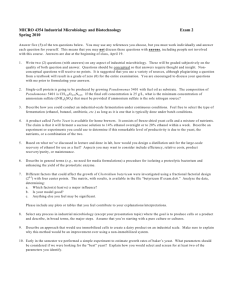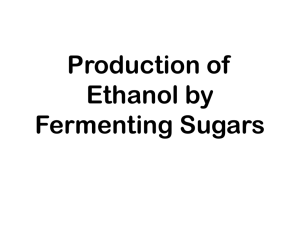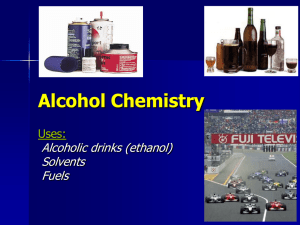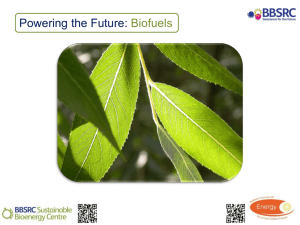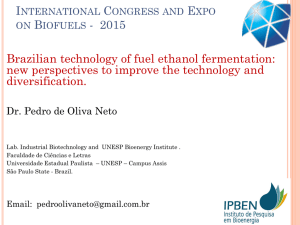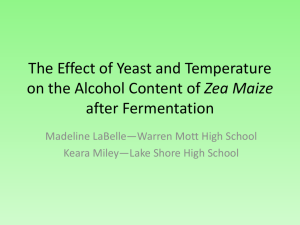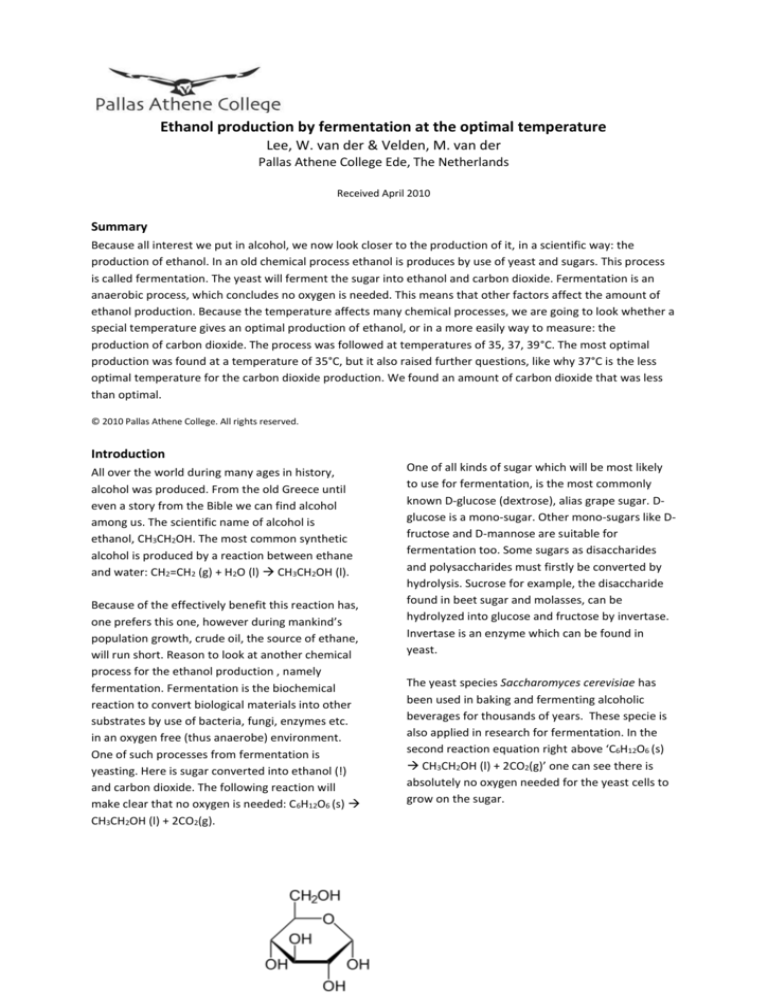
Ethanol production by fermentation at the optimal temperature
Lee, W. van der & Velden, M. van der
Pallas Athene College Ede, The Netherlands
Received April 2010
Summary
Because all interest we put in alcohol, we now look closer to the production of it, in a scientific way: the
production of ethanol. In an old chemical process ethanol is produces by use of yeast and sugars. This process
is called fermentation. The yeast will ferment the sugar into ethanol and carbon dioxide. Fermentation is an
anaerobic process, which concludes no oxygen is needed. This means that other factors affect the amount of
ethanol production. Because the temperature affects many chemical processes, we are going to look whether a
special temperature gives an optimal production of ethanol, or in a more easily way to measure: the
production of carbon dioxide. The process was followed at temperatures of 35, 37, 39°C. The most optimal
production was found at a temperature of 35°C, but it also raised further questions, like why 37°C is the less
optimal temperature for the carbon dioxide production. We found an amount of carbon dioxide that was less
than optimal.
© 2010 Pallas Athene College. All rights reserved.
Introduction
All over the world during many ages in history,
alcohol was produced. From the old Greece until
even a story from the Bible we can find alcohol
among us. The scientific name of alcohol is
ethanol, CH3CH2OH. The most common synthetic
alcohol is produced by a reaction between ethane
and water: CH2=CH2 (g) + H2O (l) CH3CH2OH (l).
Because of the effectively benefit this reaction has,
one prefers this one, however during mankind’s
population growth, crude oil, the source of ethane,
will run short. Reason to look at another chemical
process for the ethanol production , namely
fermentation. Fermentation is the biochemical
reaction to convert biological materials into other
substrates by use of bacteria, fungi, enzymes etc.
in an oxygen free (thus anaerobe) environment.
One of such processes from fermentation is
yeasting. Here is sugar converted into ethanol (!)
and carbon dioxide. The following reaction will
make clear that no oxygen is needed: C6H12O6 (s)
CH3CH2OH (l) + 2CO2(g).
One of all kinds of sugar which will be most likely
to use for fermentation, is the most commonly
known D-glucose (dextrose), alias grape sugar. Dglucose is a mono-sugar. Other mono-sugars like Dfructose and D-mannose are suitable for
fermentation too. Some sugars as disaccharides
and polysaccharides must firstly be converted by
hydrolysis. Sucrose for example, the disaccharide
found in beet sugar and molasses, can be
hydrolyzed into glucose and fructose by invertase.
Invertase is an enzyme which can be found in
yeast.
The yeast species Saccharomyces cerevisiae has
been used in baking and fermenting alcoholic
beverages for thousands of years. These specie is
also applied in research for fermentation. In the
second reaction equation right above ‘C6H12O6 (s)
CH3CH2OH (l) + 2CO2(g)’ one can see there is
absolutely no oxygen needed for the yeast cells to
grow on the sugar.
CO2 production
CO2 pruduction (g)
2,500
2,000
Our interest in yeast cells raised many questions.
One which answer benefits the productivity of the
ethanol production is: what temperature is the
optimal temperature for the ethanol production by
fermentation?
Our hypothesis about that question is that it will be
around the body temperature, because yeast cells
are eukaryote living organisms which are like
enzymes etc. and work optimal at a temperature
around the 37°C
temperature. This, or our experiment is
untrustworthy.
Experimental design
Evaluation
First we prepared a 18% D-glucose solution by
putting 18 gram D-glucose and 0,125 gram yeast
cells together and filling it with water till 100 mL.
We did this six times, for six erlenmeyers. The
erlenmeyers were labelled with the right
temperature; two erlenmeyers with 35 °C, two
with 37 °C, and 2 with 39 °C parafilm were put on
the erlenmeyers and tiny holes were pierced
through them. We weighted them all and put them
in an area with the right temperature. The bottles
were kept there for a couple of days and were
weighted again. The difference in mass was
calculated. This procedure was repeated with one
erlenmeyer instead of two.
During the weighting, we discovered that the
erlenmeyers which were put in an 37 °C area, had
become slightly heavier. We wondered if it had
anything to do with the fact that they were being
put in a water bath, and not, like the others, in a
incubator. Was there a possibility that some water
had sneaked through the tiny holes in the
parafilm? Or was there both an inaccuracy in the
weighting and an unforeseen fact that at 37 °C
yeast cells produce less gas than at 35 and 39 °C?
37
39
1,000
0,500
0,000
34
35
36
37
38
39
40
Temperatuur (°C)
So for improvements maybe we could examine
whether the water bath does matter or not.
Bibliography
http://www.yeastgenome.org/VLwhat_are_yeast.
html
Results
Temperature (C)
35
1,500
Mass Lost (g)
2.216
2.231
2.623
0.144
0.089
0.406
Averaged
2.357
1.717
2.076
2.605
2.133
http://www.yobrew.co.uk/fermentation.php
http://www.newton.dep.anl.gov/askasci/mole00/
mole00195.htm
0.213
http://herbarium.usu.edu/fungi/funfacts/Fermenta
tion.htm
Discussion and conclusion
According to the results, the amount of produced
CO2 was the highest at 35 °C. This means the
production of ethanol is the highest at 35 °C, too.
So it was not at 37 °C, what we expected. Probably,
yeast cells do not work optimal at body


